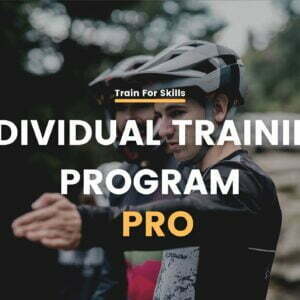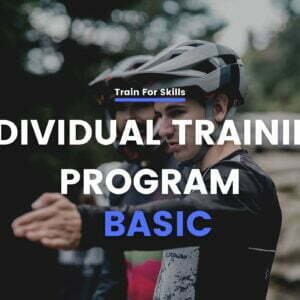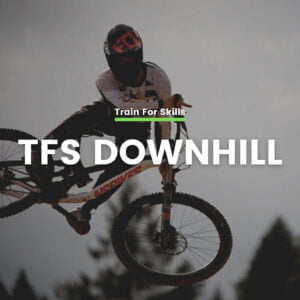We all know that in Enduro fitness and endurance play a key role. The time out of the competition season is a perfect time to build or strengthen them. This is when we should build our “engine”, the popular aerobic base. You’ve probably heard more than once: “today I’m doing cardio”. But what does this cardio mean? What is fitness? What exactly is it and how does it affect our performance? In this and several following articles we will take a closer look at how the fitness preparation in mountain biking should look like. And today – let’s start with the basics.
“Energy” in a nutshell
Fitness is related to the energy of our body, and our muscles can function thanks to the supply of energy – molecules ATP (adenosine triphosphate). They are produced in two ways – with and without oxygen, and we distinguish 3 energy systems.
- The first of these is the aerobic/aerobic system. Here, molecules are made from simple carbohydrates (aerobic glycolysis) and fats (lipolysis), and even proteins. As a result, we get a lot of energy, but slowly (36 parts ATP from 1 part glucose). This is low intensity riding, typically 55-75% VO2max.
- The second is the glycolytic system, ATP is produced from carbohydrates without the use of oxygen, anaerobic glycolysis occurs. As a result, we get energy quickly, but for a short time (max 2 min, 2 parts ATP from 1 part glucose). We run at high power, above the lactate threshold.
- The third system is the phosphagen system. Phosphocreatine combines with ADP (Adenosine-5-diphosphate) to form ATP. This is where the most intensive efforts take place, i.e. developing maximum power, energy is created very quickly and used very quickly. Usually such efforts do not last more than ~10 seconds.

Training zones
Based on how our body generates energy and functions we can distinguish the following training zones. They are the basis for planning workouts because they allow us to assess how hard our body works, what energy system we develop and what ability we develop. We distinguish 5 heart rate zones and 7 power zones. They overlap with each other, but the 2 most intensive power zones do not apply to the heart rate, because the heart’s reaction to strong efforts of a few seconds will be delayed.

Training Monitoring
OK, but how do I know how hard my body is working, what kind of work I’m doing? We can do this in different ways, the most popular are:
- RPE – perceived exertion scale – the simplest and available for everyone, we determine the training load by multiplying the exertion time by its RPE value. It is subjective and depends on psychological factors
- Heart Rate (HR)- based on it we can determine the internal load of the body, it is enough to have a wristband/watch with heart rate measurement, although the most accurate are chest straps. Unfortunately, our heart rate is a reactive value, which means that it is strongly dependent on factors such as temperature, mood, hydration, caffeine, diet, pre-race or life stress (e.g. cortisol increases it). It is time-delayed in relation to power, therefore it is not applicable to short intense efforts.
- Speed – the only thing we need is a speedometer, but these days at the beginning a smartphone and applications such as Strava will suffice. It is an objective measurement and relatively accurate. But in cycling also depends on external factors such as: type of surface (gravel vs road), surface condition (snow vs mud vs dry), wind – so measurements from the same route may not be perfectly precise.
- Power/Power – the most accurate measurement that currently exists. It is objective and most importantly – reliable regardless of any other factors. We can accurately calculate 7 power zones or power to weight (W/kg). We can make precise programming of the workout and its control. The only drawback – the price, this is the most expensive variant of the present here, but for an ambitious athlete – definitely a subject to consider.

The heart rate and RPE scale show us what our workload is, i.e. how hard the body has to work to get the job done. Power and speed, on the other hand, clearly tell us how much work has been done. Heart rate zones are fixed and power zones ‘go up’ with our state of training.
What you choose should depend on your budget, whether you are an athlete fighting for hundredths of a second or rather an amateur training for pleasure, that is your needs. The more thorough the training, the better the results will be.
Fitness vs. form
You have probably already heard about these terms. Both affect each other, but as you may be surprised – inversely proportionally.

As we train, we increase the training load, we adapt to it, and so our fitness increases (some authors also use the term fitness). Along with higher loads we induce more fatigue in the body. That’s why we can’t train all the time and we have to include time for regeneration.
As it is also commonly known – when we are tired we are unlikely to achieve good results. And here we come to the concept of form – it is the ability to achieve high results. This kind of race readiness – to put it simply. The condition is the level of training of the athlete.
How to be in good shape and highly trained? The key is to know two properties. Our condition increases slowly, while fatigue increases quickly (it usually stops within a few days). During the winter the goal is to raise our training level as high as possible, which ends around the end of the preparation period. During the competition phase the goal is to stabilize fitness, remove fatigue to maximize form for important competitions. In theory it sounds simple enough, but in practice it never looks so ideal.
Characteristics
Just as we have character traits we also have training traits. We can say that they define our abilities directly connected with situations in the field, while energy systems define what happens to our body physiologically. Zones help us train appropriately to develop the right abilities. It is a bridge between physiology and practice. There are 3 basic and 3 advanced features:

Basic factors
- Endurance – the basis, the foundation of our fitness. Strengthening slow contractile fibers, this is work in the 2nd zone. Well developed endurance allows us to regenerate faster, to ride longer at a steady, relatively calm pace. The better developed endurance we have, the better power we will develop at higher intensities. It is crucial if we want to spend long days (6-8h) on a bike without worrying if we can ‘make it’.
- Strength – the stronger our legs are the more economically we can ride. High level of strength helps us during steep ascents, and we develop it mainly in the gym, but on a bike it is also possible.
- Speed – in other words, technical skills. Moving smoothly, efficiently, pedaling with an even, high cadence. Moving through difficult terrain smoothly and without unnecessary movements. High technique manifests itself in high economy of movement, which contributes to higher overall endurance because – logically – we tire the bike less on the trail and let it go, not hindering but helping.
Advanced factors
- Strength endurance – this is dealing with a heavy load over a long period of time. It allows us to keep our technique at a high level at the end of a competition/race. It is effective in improving both aerobic and anaerobic fitness with a low risk of overtraining.
- Anaerobic endurance – that is, resisting fatigue at very high effort levels and at high cadence. We develop it in two ways: intervals that increase VO2max or short repetitions above the lactate threshold (zone 6-7). Training with this trait is very taxing, so we don’t do them more than 1-2 times a week
- Power – the ability to quickly apply maximum force or, in other words, to do as much work as possible in as little time as possible. It can be seen during short climbs, starts, sprints, with sudden changes in speed. We use it best when we are rested, at the beginning of training
We start shaping the basic characteristics together with the beginning of a new training season. Usually it is around October-November. Advanced traits start training about 12 weeks before an important race. This is usually around February-March. Throughout the start period, we will keep the traits at a high level and work on our limiters – weak points.
What we maintain depends on the requirements of the discipline or the race itself. For downhill it will be mainly power, strength, technique and anaerobic endurance. In enduro it will be more powerful and anaerobic endurance and technique, due to the longer duration of the sections and the less forceful nature of them.
When should we do what? How to shape particular traits, systems? I will discuss practical examples in next articles.
PS. Use the code “START” and receive 10% off your first month in the TFS Enduro or TFS Downhill program.
Bibliography:
- Power meter training manual, J.Friel, 2014
- Mountain Biker Training Bible, J.Friel, 2010
- Periodization Training For Sports, T. Bompa, C. Buzzichelli




